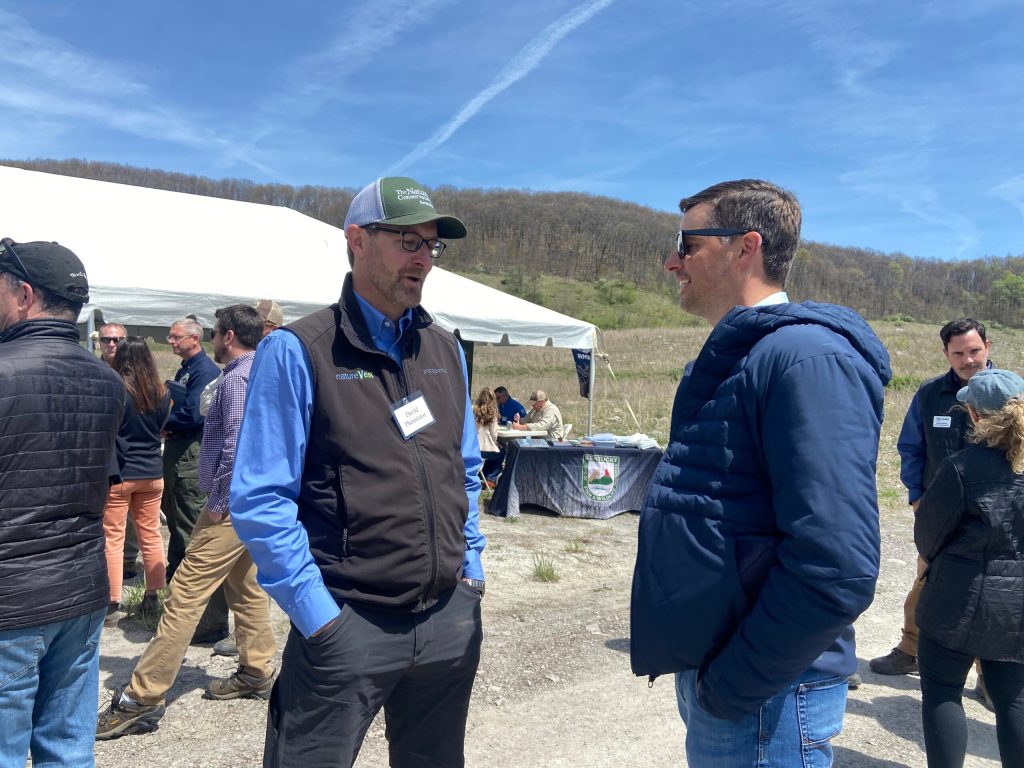‘Dream come true:’ Historic conservation project in EKY was far from guaranteed
Published 2:55 pm Wednesday, April 24, 2024

- The Nature Conservancy state director David Phemister (left) and Representative Adam Bowling, R-Middlesboro, talk at the celebration of a 55-acre conservation easement which includes parts of Bell, Leslie and Knox counties in Eastern Kentucky.
MIDDLESBORO — Senator Robin Webb remembers going to Perry County in 1997 to watch the first Rocky Mountain elk release with her father. It was the first step of Kentucky’s elk restoration program, and it took place on reclaimed coal mine land.
Tuesday, Webb teared up as she once again stood on reclaimed mine land, this time in Bell County, celebrating another historic moment—the procurement of the largest conservation easement in Kentucky history.
She said it was the highlight of her career.
Trending
In late 2023, a 55,000-acre portion of Bell, Leslie and Knox counties was put into a permanent conservation easement with the help of The Nature Conservancy, the Kentucky Department of Fish and Wildlife Resources and the Rocky Mountain Elk Foundation.

The 55-acre conservation easement includes parts of Bell, Leslie and Knox counties in Eastern Kentucky.
What are conservation easements and why are they important?
Conservation easements are permanent legal agreements to protect natural resources on a property.
This one is now held by the Kentucky Department of Fish and Wildlife Resources, which will be responsible for preserving the land’s ecological value, managing elk and other wildlife habitats and maintaining public access for fishing, hunting and recreation.
The easement restricts large-scale development and land subdivision. It allows for conservation projects like carbon sequestration and reforestation on the 55,000-acre area.
“We’re losing generations of knowledge and participation because we’re competing with video games and all that, the anti-hunters, anti-fishing agendas,” Webb said. “We’ve got to build alliances like we have today…to continue for our children and grandchildren to have the same access and enjoyment that our fathers gave us.”
The 55-acre conservation easement is important for three reasons, said David Phemister, The Nature Conservancy’s Kentucky director.
First, it’s huge—approximately the size of 7% of Rhode Island or a quarter of Bell County. That’s a rare opportunity in the Eastern U.S., Phemister said.
Second, the Eastern Kentucky easement is located in the heart of the Appalachian corridor, which runs from Alabama to Canada. Its temperate hardwood forests provide a critical, and increasingly rare, passage for wildlife in the face of climate change and deforestation.
Third, the easement helps the people of the region by ensuring permanent public access. Hunting and recreation-based tourism is an economic driver, particularly to combat losses from coal mine closures.
“We see nature as being an engine for economic revitalization in the Appalachians, and this project is a bright spot,” Phemister said. “And it’s part of a new narrative around restoration and reinvestment that’s really gaining momentum in these mountains.”
Webb agreed, and said to expect more projects like this. Recently, the Middlesboro area has celebrated the reclamation of Starfire Mine land for a solar project, as well as installed solar panels on its community center.
“These economies have to transform themselves and energy is important to everybody,” Webb said. “Energy is what we know. In any form of energy you’re gonna have a ready workforce. It’s hard to transition from coal for a lot of cultural reasons.”
A political uphill battle
When Fish and Wildlife Commissioner Rich Storm first heard about this project, he said he “believed a lie:” that it would be impossible to achieve.
After TNC bought the land from mining and logging companies in 2019, they got to work trying to set up permanent public access. While they had an annual agreement maintaining access, that could go away at any time if anyone ever bought the land from TNC.
But at the time, the Fish and Wildlife Commission was blocked from buying land. Recent audits under the previous commissioner had shown a history of circumventing rules.
When the commission, helmed by Storm, tried to buy the land in 2019 and 2020, he said it was blocked.
But TNC representatives kept showing up in Frankfort, and eventually assembled a team of supporters that carried two major reforms in 2022 and 2023—Senate Bills 217 and 241, respectively—that gave KFW more autonomy to buy land.
Sens. Brandon Smith, R-Hazard, the chairman of the Natural Resources and Energy Committee, was key in shepherding the legislation through. Webb and Rep. Adam Bowling, were also critical members of the team.

Members of the General Assembly, TNC state director David Phemister and Rocky Mountain Elk Foundation representatives won awards for their work in acquiring a 55,000-acre conservation easement which includes parts of Bell, Leslie and Knox counties in Eastern Kentucky on Tuesday, April 23, in Bell County.

Members of the General Assembly, TNC state director David Phemister and Rocky Mountain Elk Foundation representatives won awards for their work in acquiring a 55,000-acre conservation easement which includes parts of Bell, Leslie and Knox counties in Eastern Kentucky on Tuesday, April 23, in Bell County.
TNC also managed to get a $3.8 million appropriation in the last budget to match a $12 million federal grant for the project.
The project could have been killed at several points.
Long before TNC’s investors acquired the property, the property’s mineral rights were severed from the surface rights, meaning that different parties controlled each set of rights.
Senate President Robert Stivers and Webb discussed the property’s existing severed mineral rights, and they agreed that the easement should proceed as long as its language was clear that it did not affect existing severed rights. Mineral rights allow a third party to conduct coal, oil and gas production on the land.
Webb said that was important to get everyone in the legislature on board. The goal was to solve a problem before it happened, she added.
Another turning point was keeping the easement on the local property tax base, Bowling said.
Gov. Andy Beshear vetoed this legislation, writing that it put too much power into the hands of a Department of Fish and Wildlife Resources that had failed the public in the recent past.
But Webb said that legislators were convinced by the partnership of the three organizations. They were credible, had a specific and united goal and were always accessible for questions. The legislature just had to fill a gap in existing federal funding.
Storm said the announcement was about more than 55,000 acres. The historic project sets a standard for future conservation easements across Kentucky.
Phemister called it a “dream come true.”


